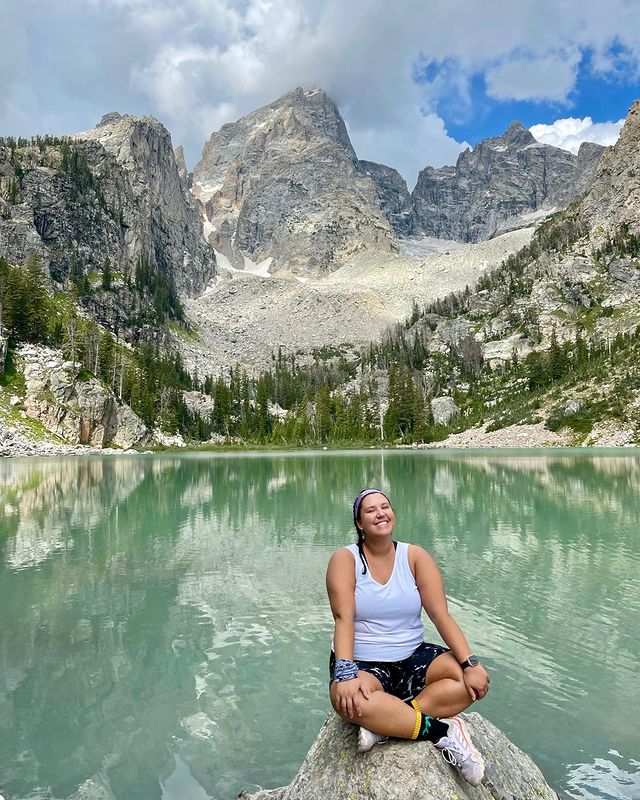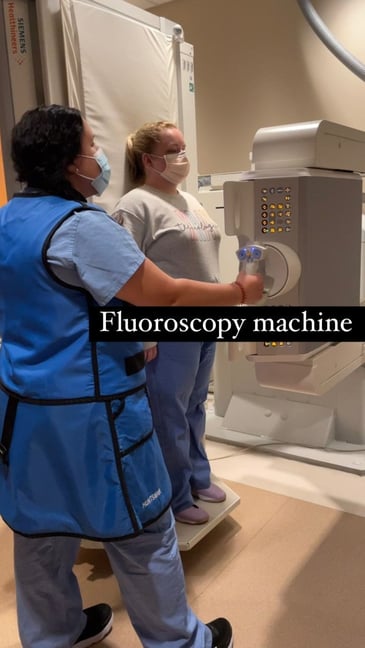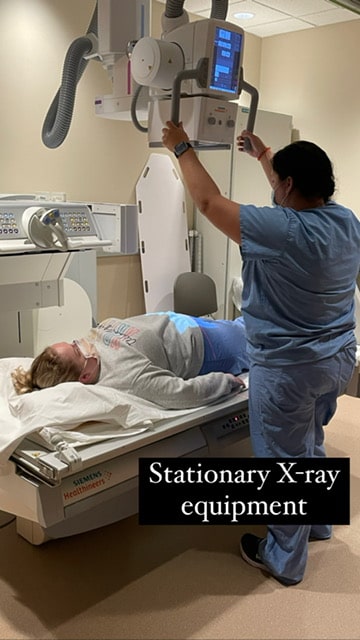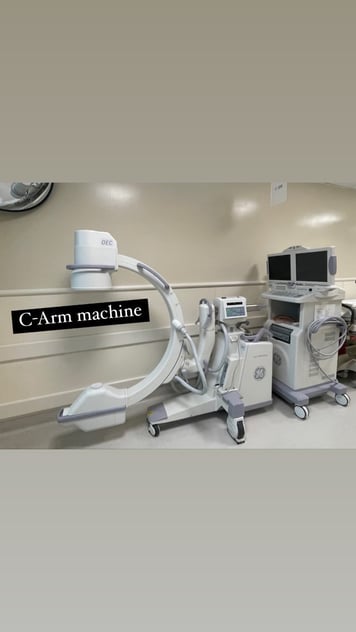.jpg?width=785&height=589&name=thumbnail_image0-min%20(1).jpg) Usually when we think about radiology, our minds automatically go to X-rays and other scans or images. But that’s not all radiology is! Radiology also includes those professionals who snap the pictures of our insides to get a better look at what is going on in there. Those medical workers are called radiologic technologists, or rad techs. And yes, they're rad (wink, wink).
Usually when we think about radiology, our minds automatically go to X-rays and other scans or images. But that’s not all radiology is! Radiology also includes those professionals who snap the pictures of our insides to get a better look at what is going on in there. Those medical workers are called radiologic technologists, or rad techs. And yes, they're rad (wink, wink).
A Day in the Life of a Rad Tech
What is a radiologic technologist?
Rad techs, also known as radiographers, play a unique role in the medical industry and are part of a very in-demand medical profession. In fact, according to The American Registry of Radiologic Technologists (ARRT), radiologic technologists make up the third-largest group of medical professionals, right behind physicians and nurses.
Experts in high-tech medical equipment, these professionals know the ins and outs of diagnostic imaging. From operating the machinery to positioning the patient, rad techs do it all. One of their main job functions is to create images of patients’ bodies using medical equipment like X-rays, magnetic resonance imaging (MRI) scans, computed tomography (CT) scans, fluoroscopy, or sonography tools. In addition to helping to figure out what’s going on inside of a patient, rad techs may assist physicians in medical procedures, such as an angioplasty or a stent insertion.
“Rad techs help doctors determine what is wrong with their patients,” said Fusion rad tech traveler Alisha. “Without us, nobody could see the broken bones or different pathologies that can be seen with X-rays. The radiology department is essential for good patient care and diagnosing different patient ailments.”
Q&A with Fusion traveler Amanda Salazar, Rad Tech

To find out more about a day in the life of a rad tech, we sat down with Fusion traveler Amanda, for a casual Q&A. Here’s what we learned.
Megan Bebout: Hi Amanda! Thanks so much for being here with us today and chatting with us. To start, why don’t you tell us a little about yourself.
Amanda Salazar: Hello! My name is Amanda Salazar. I was born and raised in Illinois where I also went to school and completed a bachelor’s degree in Psychology. I then decided to move to Orlando, Florida where I started my career in hospitality, but I decided that career path was not for me. I looked into health care careers because I wanted a job that made me feel more fulfilled. I was deciding between nursing, occupational therapy (OT), and radiography, but I ultimately chose radiography because it was a perfect combination of patient care and technology! I have now been a Radiology Technologist for about two and a half years.
MB: It’s so cool that you dabbled in a few different things before finding radiology! So, how long have you been traveling?
AS: I have been traveling now for nine months. I began my travel journey completely open with no idea or preference on where I wanted to go. The recruiter I began working with is named Stephanie Kastler, and she has been absolutely amazing every step of the way. I am traveling with my partner who is a Physical Therapy Assistant (PTA) and finding contracts in the same area has not been the easiest. Because of this, we have extended twice at our current location in Salt Lake City (you can stay in one location for up to 364 calendar days without losing traveler benefits). Traveling together can be difficult at times, but I am so thankful to have my boyfriend with me, so I am able to come home to him on the hard days but also have him to join me on all the weekend adventures!

MB: OMG, incredible. What made you decide to start traveling?
AS: I first became interested in traveling because of the pay, just like most people. To be honest, it sounded too good to be true! Although I loved my job, coworkers, and schedule, I also was excited at the idea of change. I want Florida to be my forever home, but there is still so much of the U.S. I haven’t seen!

I loved the thought of being paid to travel for work and adventure to new places on my days off. I also have three family members who are health care travel workers, so after speaking with them, I decided to start looking into it more seriously. I originally started with Fusion Medical Staffing because my sister travels with them, as well. The website was extremely appealing to me because it was easy to navigate and straight to the point. Once I started working with my recruiter Stephanie, she really helped me progress and feel comfortable taking the leap!
MB: Quick shoutout to Stephanie! Shifting gears a little, can you walk us through what an average day looks like for a rad tech?
AS: Radiologic technologists work in multiple different settings. I have had past jobs and experience in large hospitals, small hospitals, and outpatient settings, and each location was quite different. An outpatient center is the most routine, in the sense that you generally know what type of patient interaction you will have. Those patients generally are “walkie talkie” and can follow directions easily and painless.
In a hospital setting, you never know what type of patient you may come across. They may be unconscious or sedated and cannot follow any directions, they may be in severe pain and cannot do what you ask of them, or they may be able to move without restrictions. Hospital radiology also has rad techs assist in fluoroscopy studies and surgeries. Fluoroscopy is a dynamic X-ray study, meaning it is, more or less, an “X-ray movie.” You are able to capture movement and different views via video with X-ray, such as swallowing. Surgical procedures use X-ray to help place hardware, catheters, and more. Radiology imaging truly helps the doctors visualize inside the human body.
MB: So, each day is different, that makes sense. What kind of equipment do rad techs use?
AS: There are three main machines we use as radiologic technologists. The first is a standard, stationary X-ray machine. This machine is inside of the X-ray rooms and is used on outpatients or inpatients who need to come down to the department for certain exams. There is also a portable X-ray machine. This machine is motorized, and we are able to bring it directly to the patient in their room or in the ER. The portable machines are very fast and efficient because the patients do not need to be transported around the hospital. The third type of equipment we use are fluoroscopy machines. There is usually a fluoroscopy machine in the stationary X-ray room, and there is also a C-Arm machine that we can drive around and use in surgery cases.




MB: Technology is so cool! I had no idea about the different equipment you work with. Now, in addition to being technologically savvy, what are special skills needed to be successful as a rad tech?
AS: In order to be a radiologic technologist, I think it is important to have customer service experience because it is a good stepping stone to patient care. Working in a health care setting, it is important to be empathetic and caring to your patients. It’s also important to know how to communicate with frustrated, sad, or angry patients and to not take it personally because these patients may be uncomfortable, scared, or nervous.
It is also important to be able to think critically. No two patients are the same. Each exam is different from the last depending on injury or body habitus, so you must be able to adjust accordingly. The longer you work in the field, the more experience you have and will be able to adjust quickly.
MB: I love your point about customer service experience being a stepping stone to patient care, that’s so true. Okay, almost done: what do you find rewarding about being a rad tech?
AS: I genuinely enjoy my job as a rad tech. I find it to be extremely fulfilling working in health care. My goal with each patient is to make it a positive interaction, no matter what the situation is. If I am able to, I try to talk to my patients about more than just their exam, so they feel more like a person and less like a patient. I also enjoy the mix of patient interaction and technology/machinery.
Each day as a rad tech is different than the last. Some days may be slow, and some days may be filled with ER trauma or surgery trauma. I feel like I am constantly learning new techniques or strategies, and I enjoy that. Working as an X-ray tech, you also have the ability to continue your education and become a CT tech, MRI tech, mammography, interventional radiology tech, and more.
MB: On the flip side, what are the challenges of being a rad tech?
AS: Every career will have its pros and cons. Some days are extremely busy and fast-paced, which is exhausting. The equipment and machinery can also stop working correctly, and it can completely throw off your day and cause delay, which is a chain reaction for the patient’s care. Generally, most people find the surgery aspect for X-ray to be the most challenging. Working side-by-side with the surgeons can be stressful, especially during difficult cases. With time and experience, the C-Arm machine used during surgery becomes easier, and this helps the cases to run smoother.
MB: Oof, surgery does sound challenging! Wrapping up, why would you recommend a rad tech career to others?
AS: I would absolutely recommend radiologic technology as a career to others. Working in health care is extremely fulfilling, and I find working in X-ray to be fun! Once becoming a rad tech, there is the option to continue to other modalities, so if one modality begins to feel stagnant, try another! I personally enjoy the mix of patient interaction and technology, as well as surgery cases. This career is stable, and there are many different settings one can work in, such as a hospital, urgent care, outpatient, orthopedic center, and more. Looking back, I’m extremely thankful I took the jump and started my career in radiography!
MB: Thank you so much, Amanda! We appreciate you sharing your awesomeness with us.
AS: Of course!
How to become a radiologic technologist
Do you want to become a radiologic technologist? To become a rad tech, you’ll need to first earn a high school diploma or GED. Afterwards, you’ll need higher education in radiology technology from a certification program, associate degree, or bachelor’s degree. Pro tip: make sure the radiology tech program is accredited by the Joint Review Committee on Education in Radiologic Technology (JRCERT).
Once you’ve completed your education, it’s time to get certified. To do this, ensure you meet the ethics requirements, then complete and submit an ARRT application. Next, schedule and take your certification exam! From there, all you have to do is wait for the passing grade. In short, to become a radiologic technologist, you need at least an associate degree from a program that’s accredited by the JRCERT, certification by the ARRT or certification from the state from where you’re practicing.
Like other medical professionals, radiologic technologists promote safety and provide the highest level of patient care possible. As important members of medical teams, rad techs help uncover health problems in patients that can ultimately save lives. If that sounds like the job for you, combine your travel life with your perfect career and enjoy the freedom to call your own shots.





